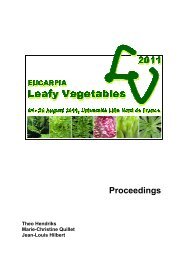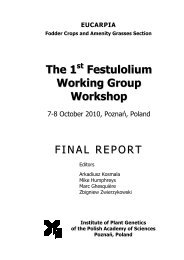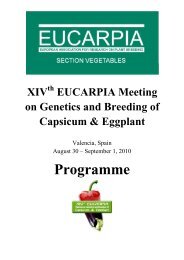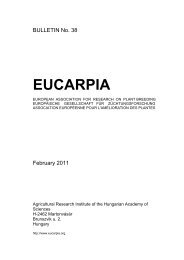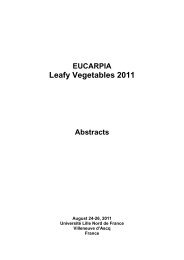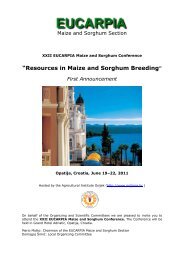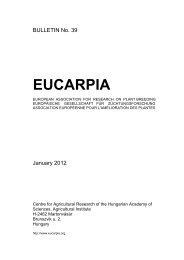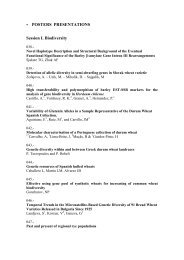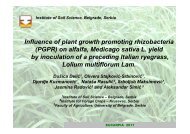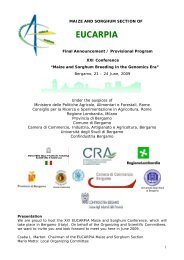Plant breeding for organic and sustainable, low-input agriculture
Plant breeding for organic and sustainable, low-input agriculture
Plant breeding for organic and sustainable, low-input agriculture
You also want an ePaper? Increase the reach of your titles
YUMPU automatically turns print PDFs into web optimized ePapers that Google loves.
Pre<strong>breeding</strong> methods used on Portuguese maize germplasm <strong>and</strong> its applications <strong>for</strong><br />
on-farm conservation.<br />
Pedro Mendes Moreira 1 , Carlota Vaz Patto 2 , João Santos 1 , Liliana Morgado 1 , João Santos 1 ,<br />
Silas E. Pêgo 3<br />
1 Escola Superior Agrária de Coimbra, Coimbra, Portugal;<br />
2 Instituto de Tecnologia Química e Biológica, Universidade Nova de Lisboa, Oeiras, Portugal;<br />
3 Instituto Nacional de Recursos Biológicos/Estação Agronómica Nacional, Oeiras, Portugal.<br />
After its introduction from America, by Columbus, maize was spread over Portugal <strong>and</strong> evolved<br />
in an enormous range of natural cultivation conditions (e.g. topography, microclimate, precocity,<br />
pest <strong>and</strong> disease resistance). This process gave place to the development of different l<strong>and</strong>races,<br />
i.e., genetic adaptation under human selection. These maize l<strong>and</strong>races, mass reservoirs of genetic<br />
adaptability, have there<strong>for</strong>e a valuable conservation function, justifying the existence of a<br />
participatory conservation program. Subjacent to the conservation of maize germplasm, a<br />
Participatory Maize Breeding (PMB) project was initiated in 1984 by Silas Pêgo in the Sousa<br />
Valley (VASO), Portugal. This project was planned to answer the problems of small farmers, i.e.<br />
increasing yield without losing the parameters defined <strong>and</strong> important to the farmers, as suitability<br />
<strong>for</strong> polycrop systems, quality <strong>and</strong> adaptability to <strong>low</strong> <strong>input</strong> <strong>sustainable</strong> <strong>agriculture</strong>.<br />
In order to screen new potential germplasm, either <strong>for</strong> classical <strong>breeding</strong>, either <strong>for</strong> on-farm<br />
conservation <strong>and</strong> <strong>breeding</strong> projects, where adaptation to <strong>organic</strong> farming <strong>and</strong> polycrop systems<br />
could be easily fitted, some pre-<strong>breeding</strong> methodologies, according to Pêgo, are being used (e.g.<br />
Hunters, Overlapping Index).<br />
L<strong>and</strong>races obtained from collecting missions are being submitted to Hunters, Overlapping Index<br />
<strong>and</strong> ear characterization methods. Yield trials are also being done.<br />
The results obtained from the pre-<strong>breeding</strong> evaluations are being used <strong>for</strong> future implementation<br />
of new on farm <strong>breeding</strong> <strong>and</strong> conservation programmes. A holistic approach should be done<br />
taking into consideration:<br />
1) Genetic resources conservation <strong>and</strong> conservation of specific agroecological, cultural <strong>and</strong><br />
biological processes (e.g. co-evolution process).<br />
2) Farmer “erosion” <strong>and</strong> impact of local authorities support on marginal areas <strong>agriculture</strong>.<br />
Community recognition <strong>for</strong> the complex work done by farmer (e.g. food production, genetic<br />
resources conservation, environmental sustainability, <strong>for</strong>est protection).<br />
3) Development of the lacking appropriate legislation al<strong>low</strong>ing the certification of OPV with a<br />
certain level of heterogeneity, in order to ease distribution <strong>and</strong> commercialization.<br />
4) L<strong>and</strong>races use to create new high market value products that could be associated with <strong>organic</strong><br />
farming.<br />
61




